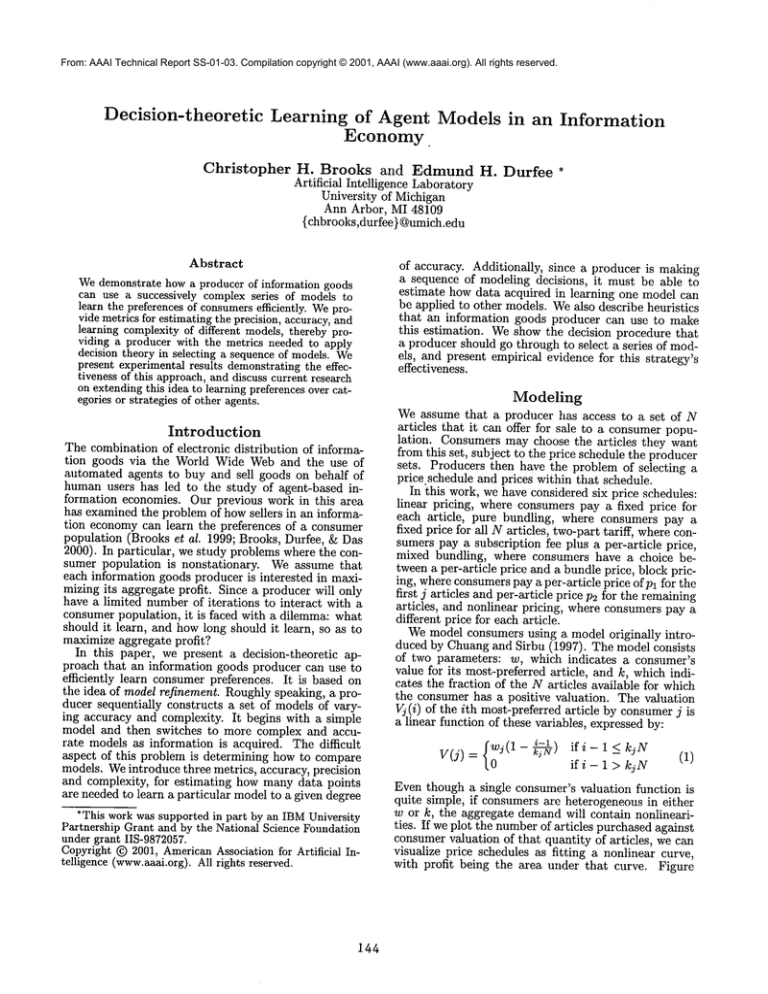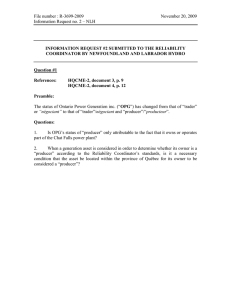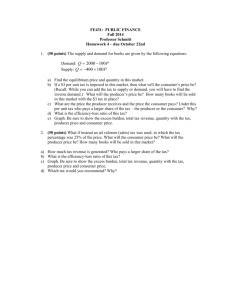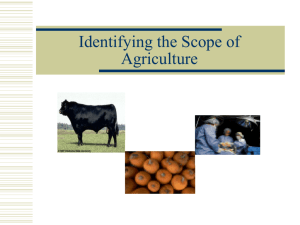
From: AAAI Technical Report SS-01-03. Compilation copyright © 2001, AAAI (www.aaai.org). All rights reserved.
Decision-theoretic
Christopher
Learning of Agent Models in an Information
Economy.
H. Brooks
and Edmund H.
Artificial Intelligence Laboratory
University of Michigan
Ann Arbor, MI 48109
{chbrooks,durfee)@umich.edu
Abstract
Wedemonstrate howa producer of information goods
can use a successively complex series of models to
learn the preferences of consumersefficiently. Weprovide metrics for estimating the precision, accuracy, and
learning complexityof different models, thereby providing a producer with the metrics needed to apply
decision theory in selecting a sequence of models. We
present experimental results demonstrating the effectiveness of this approach, and discuss current research
on extendingthis idea to learning preferences over categories or strategies of other agents.
Introduction
The combination of electronic distribution of information goods via the World Wide Web and the use of
automated agents to buy and sell goods on behalf of
human users has led to the study of agent-based information economies. Our previous work in this area
has examined the problem of how sellers in an information economy can learn the preferences of a consumer
population (Brooks et al. 1999; Brooks, Durfee, & Das
2000). In particular, we study problems where the consumer population is nonstationary.
Weassume that
each information goods producer is interested in maximizing its aggregate profit. Since a producer will only
have a limited number of iterations to interact with a
consumer population, it is faced with a dilemma: what
should it learn, and howlong should it learn, so as to
maximize aggregate profit?
In this paper, we present a decision-theoretic
approach that an information goods producer can use to
efficiently learn consumer preferences. It is based on
the idea of model refinement. Roughly speaking, a producer sequentially constructs a set of models of varying accuracy and complexity. It begins with a simple
model and then switches to more complex and accurate models as information is acquired. The difficult
aspect of this problem is determining how to compare
models. Weintroduce three metrics, accuracy, precision
and complexity, for estimating how many data points
are needed to learn a particular modelto a given degree
*This work was supported in part by an IBMUniversity
Partnership Grant and by the National Science Foundation
under grant IIS-9872057.
Copyright ~) 2001, AmericanAssociation for Artificial Intelligence (www.aaai.org).All rights reserved.
144
Durfee
*
of accuracy. Additionally, since a producer is making
a sequence of modeling decisions, it must be able to
estimate how data acquired in learning one model can
be applied to other models. Wealso describe heuristics
that an information goods producer can use to make
this estimation. Weshow the decision procedure that
a producer should go through to select a series of models, and present empirical evidence for this strategy’s
effectiveness.
Modeling
Weassume that a producer has access to a set of N
articles that it can offer for sale to a consumerpopulation. Consumers may choose the articles they want
from this set, subject to the price schedule the producer
sets. Producers then have the problem of selecting a
price.schedule and prices within that schedule.
In this work, we have considered six price schedules:
linear pricing, where consumers pay a fixed price for
each article,
pure bundling, where consumers pay a
fixed price for all N articles, two-part tariff, whereconsumers pay a subscription fee plus a per-article price,
mixed bundling, where consumers have a choice between a per-article price and a bundle price, block pricing, where consumerspay a per-article price of pl for the
first j articles and per-article price P2 for the remaining
articles, and nonlinear pricing, where consumers pay a
different price for each article.
Wemodel consumers using a model originally introduced by Chuang and Sirbu (1997). The model consists
of two parameters: w, which indicates a consumer’s
value for its most-preferred article, and k, which indicates the fraction of the N articles available for which
the consumer has a positive valuation. The valuation
Vj (i) of the ith most-preferred article by consumerj
a linear function of these variables, expressed by:
kj--W) i-1 if if/-l>kjN
i-l_<kjN
V(j)=_ {O j(1-
(1)
Even though a single consumer’s valuation function is
quite simple, if consumers are heterogeneous in either
w or k, the aggregate demand will contain nonlinearities. If we plot the numberof articles purchased against
consumervaluation of that quantity of articles, we can
visualize price schedules as fitting a nonlinear curve,
with profit being the area under that curve. Figure
On=l.Pdclng
Puts
Bundlln
...
Two*part
tad~,,*,.
Mb;ed~x~d~ng~
BlockP~ng~Nonlinear
,, ............
family. Werefer to this as a model’s accuracy. For a
given family of models MF, let M’ be the model within
this family that maximizesprecision over a collection of
input sets S. Wecan then define the accuracy aM of a
given" model Mas:
..,,,,,,,,.,.-,-"-,"*-"-,=la,i.¯ ¯ ¯ ¯. ¯..
.......~L..-.".,:~ ,
o
...,,,.~
7,’
7,’
.....
aM = 1--
:
i
Numberof articles purchased(n)
j
aES
Figure 1: An illustration of price schedules as approximations of a nonlinear curve.
1 gives an illustration
of this, with consumer demand
denoted as ’Nonlinear’ (the nonlinear pricing schedule
can fit demandexactly), and other schedules capturing
different portions of the available profit.
Model Refinement
Werefer to the sequential selection of progressively
complex models and accurate models as model refinement. To describe model refinement, we must introduce
some terminology.
Webegin with the consumer population’s reaction
]unction. This is a function ~r : p --+ ]~. p is a price
vector, indicating the amount charged for each article
offered. This function indicates the amount the consumer population is willing to pay for any offering. We
refer to a particular p as an input set. Typically, a producer will only be concerned with modeling a reaction
function over someparticular input sets.
A model is a representation of this reaction function.
Each model has an input set i that maps to an output
in IR. All models which use the same inputs are referred
to as a model family. For example, there is the family of
linear pricing models, the family of pure bundling models, and the family of nonlinear pricing models. Within
a family, models differ only in the particular values assigned to their parameters.
Model families have two characteristics of interest¯
The first is precision. Precision indicates howclosely
the best model in a family approximates the reaction
function over a set of relevant input sets. In order to
measure precision, we must know both how different a
model is from the reaction function for each relevant
input set, and also how likely those input sets are to
occur. Let S be a collection of input sets, and Pr(s) be
the probability of a particular input set s E S occurring.
We can then compute the precision PMFof a model
family MF as:
PMF
---- argmaxMEMF
1 -- E IM(s)~)-7r(s)l Pr(s)
E
(2)
sES
In other words, this is the fraction of available profit
that the best model in this family can hope to capture
over the relevant input sets. (If S is continuous, we
integrate rather than sum.)
Wewould also like to be able to measure how good a
particular modelis, relative to the optimal modelof its
145
IM’(s) - M(s)l
~/~s~
Pr(s)
(3)
The third factor we must consider in comparing model
families is the expected time (measured in the number
of samples) needed to learn a model from that family. Werefer to this as a model family’s complexity.
The complexity C of a model family estimates how
good a solution is (as a fraction of optimal), as a function of the number of data points observed. Formally,
C(MF,n, S) = aMsays that, after n price/profit points
are observed using a model M E MF with input sets
from S, the accuracy of Mis aM.
Empirically, we have found that a sigmoid function
works well for approximating complexity, at least when
applied to pricing data. The profit landscapes tend to
be composed of large plateaus, dotted with hills that
are easy to locate and ascend initially, but which have
multiple peaks, so we would like to approximate complexity with a function that increases steeply initially,
then tails off as it approaches an asymptote. Wehave
had good results when applying the following formula
as an estimate of the solution quality after n iterations:
C(MF, n,
S) PM
-, r
(4)
l+e~
where dMFiS the dimensionality of the model family.
For example, a producer that knew it would have 20
iterations to interact with a consumer population could
use this formula to predict its performance using twopart tariff. Two-part tariff has a precision of 0.90 for
the problem described previously, and its dimensionality is 2. Let us assume that prices are within the
range [0,100]. Plugging in these numbers, we find that
C(Twopart, 20,p*) = 0.736. So, in the 20th iteration,
producer using 2-part tariff would extract 0.736 ~__. 64%
of the available profit (in expectation). By integrating
equation 4 over [0,19], we get the total profit (per customer). A producer using 2-part tariff for 20 iterations
can expect to earn a total undiscounted profit of 12.09,
or 52%of the available profit. Similarly, a producer using block pricing would have C(Block, 20,p*) = 0.695
and a cumulative profit of 11.79, so two-part tariff
would be a better model. As the number of iterations
increases, C will increase for each modeland block pricing’s higher precision will make it a more attractive
choice.
Choosing a model
If the producer is to choose a schedule and then interact
with a population for n iterations, it woulduse equation
4 to determine the profit at the current iteration and
at n iterations¯ By integrating this equation, it can
determine the expected profit for each model and choose
the model with the highest expected aggregate profit.
But what if the producer wants to change schedules
as it learns? In order to determine the optimal sequence
of models to use, a producer must consider not only
the profit a model can allow it to earn, but also what
data acquired in the context of that model allows it to
learn about other models. In the most general case, a
producer would have to consider all possible sequences
of schedules¯ Weavoid this problem by having the producer makea greedy estimate of each schedule’s benefit;
at each iteration, it chooses the schedule which it believes will yield the greatest cumulative profit. To make
this effective, we make one simple assumption: the inputs of a model family at dimension d are a subset of
the inputs of a model family at dimension d ÷ 1. For
example, linear pricing can be thought of as two-part
tariff with the subscription fee set to 0. This allows a
learning producer to perform a greedy search through
the space of modelfamilies. The question to consider is
how much is learned in the more complex model from
data collected in the simpler model¯ Our solution is to
weight the number of data points by the ratio of dimensionalities of the two models¯ That is, if a producer
collected n data points from a model of dimensionality d, we wouldtreat this as nd--~k data points for the
purposes of evaluating the complexity of a model of
dimensionality d + k. This reflects the fact that, by
learning a d dimensional model, one is also learning a
d-dimensional subspace of the larger d + k-dimensional
model.
Experimental
Results
In order to test whether a producer using model updating does in fact outperform a producer using a static
model, we conducted a set of experiments comparing
the two sorts of producers¯ Wecreated a set of producers that used static models (one for each price schedule), and had them learn the optimal prices for their
particular schedule when interacting with an unknown
consumer population having w = 10 and k drawn from
U[0,0.7]. Each producer used Amoeba(Press 1992),
an implementation of the Nelder-Mead algorithm for
nonlinear hillclimbing, to learn the optimal prices. We
comparedthese results to a decision-theoretic producer
that simultaneously maintained multiple models, which
were also learned with Amoeba. A graph comparing the
performance of an adaptive producer to static producers is shownin Figure 2.
As we can see from the graph, the decision-theoretic
learner (denoted as ’Adaptive Pricing’) is able to outperform most of the static schedules for the majority
of the experiment. The schedules used by the adaptive
learner are indicated at the top of the figure. It begins
by trying a numberof different schedules to collect data,
and then settles on linear pricing for approximately 35
iterations. It then switches to two-part tariff for about
60 iterations before moving on to block pricing. Finally, at around 300 iterations, it switches to nonlinear
pricing¯
Also, we note that there is no static schedule that
dominates adaptive pricing over the course of the entire
experiment. This implies that if a producer is unsure
of how long it will have to interact with a population,
adaptive pricing is an effective approach. In addition,
adaptive pricing performs particularly well in the ’intermediate’ range of 10-200 iterations. In this range,
146
adjusting
16000
t Linear
,
Unear Pdclng~
BlockPdaing
.N .*
12(]00 AdaptivePdcing===
~’
~
~. Iv
~*~
~°:oOO-
800O,~...~
:j 60o0r’,
i Nonllnear
a~lL~"
h,
..*~
,~
I Block
t Two-~art
,
-
/
**
.,.,~/
///~"
//
"
;~
,~
_/
........
.’,~,,.,.,.~r,~
..........................
.~F..,~,,,,,,,,
_._.
2ooo
L.:... J.
~,.
o; . .......
,o .......
Figure 2: Cumulative profit per article, per period, per
customer (N = 10) (averaged over 10 runs)
learning is able to play an important role. If a producer
has only a few iterations to interact with a population,
there, is not enough time to learn much.Conversely, if a
producer has a long time to interact with a given population, schedules can be learned exactly and long-run
steady-state profits will dominate.
Current
Research
Weare also interested in extending this idea beyond
price schedules to consumer preferences over types of
articles. If a producer must also choose what articles
to offer to a population and it has access to a (possibly
incomplete) taxonomydescribing categories of articles,
it could employthis procedure, initially offering broad
categories and refining its offerings to morespecific categories as information is acquired. As with price schedules, the challenge is in applying knowledge acquired
with one model to the updating of other models¯
Wewould also like to be able to apply this technique
to populations that learn or adapt continuously. A producer that noticed a change in the population could
temporarily shift to a simpler model, tune this model
to the new population, and then revert to a more complex schedule.
References
Brooks, C. H.; Fay, S.; Das, R.; MacKie-Mason,J. K.;
Kephart, J. O.; and Durfee, E.H. 1999. Automated strategy searches in an electronic goods market:
Learning and complex price schedules. In Proceedings
of ACMEC-99, 31-40.
Brooks, C. H.; Durfee, E. H.; and Das, R. 2000.
Price wars and niche discovery in an information economy. In Proceedings of A CMConference on Electronic
Commerce (EC-O0).
Chuang, J. C.=I, and Sirbu, M. A. 1997. Network delivery of information goods: Optimal pricing of articles
and subscriptions. In Proceedings of the Conference
on Economics of Digital Information and Intellectual
Property.
Press, W. H. 1992. Numerical Recipes. Cambridge
University Press¯








